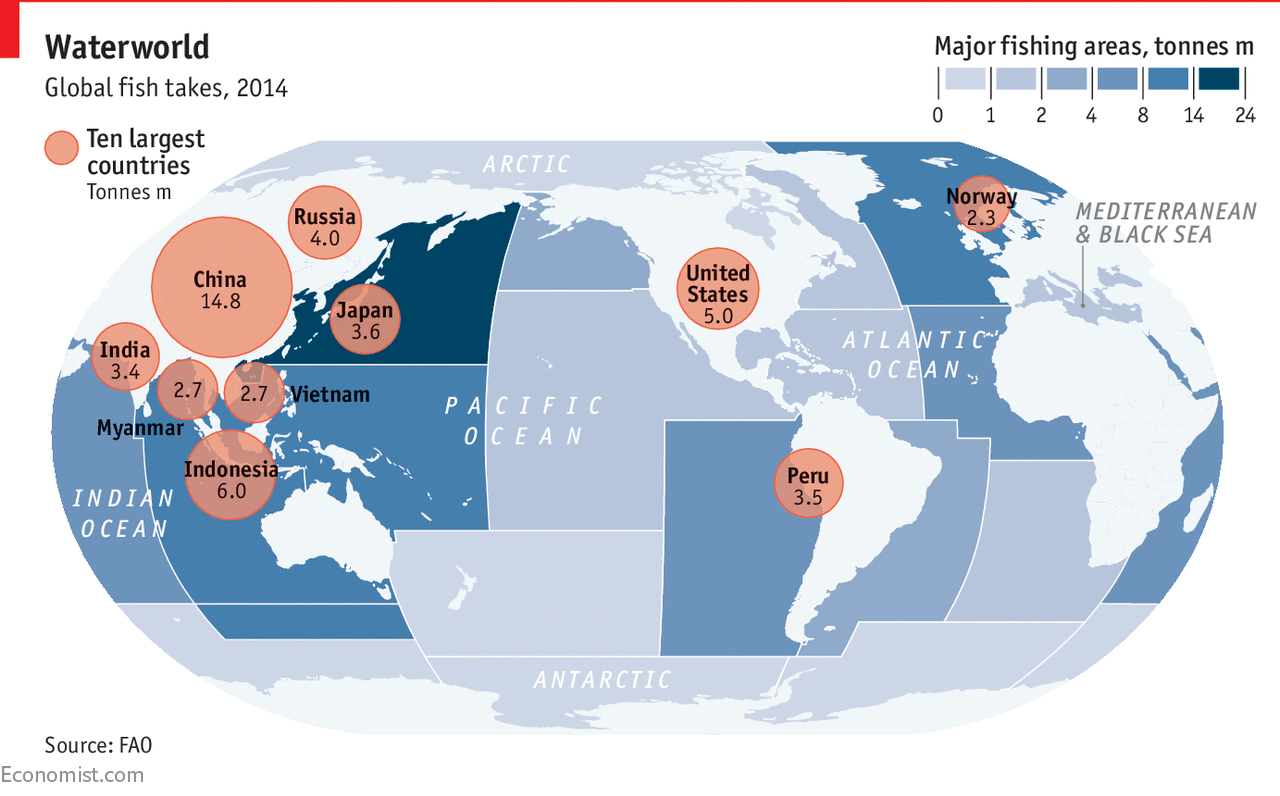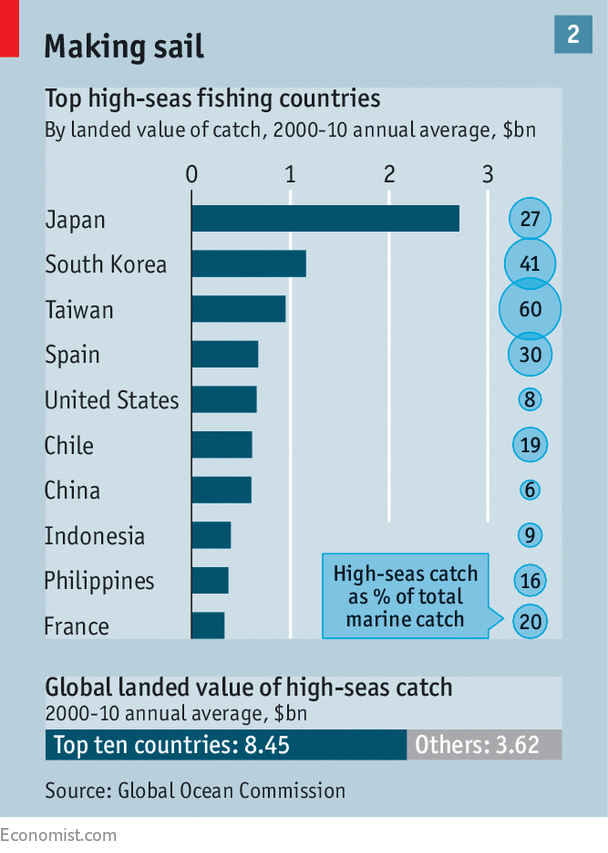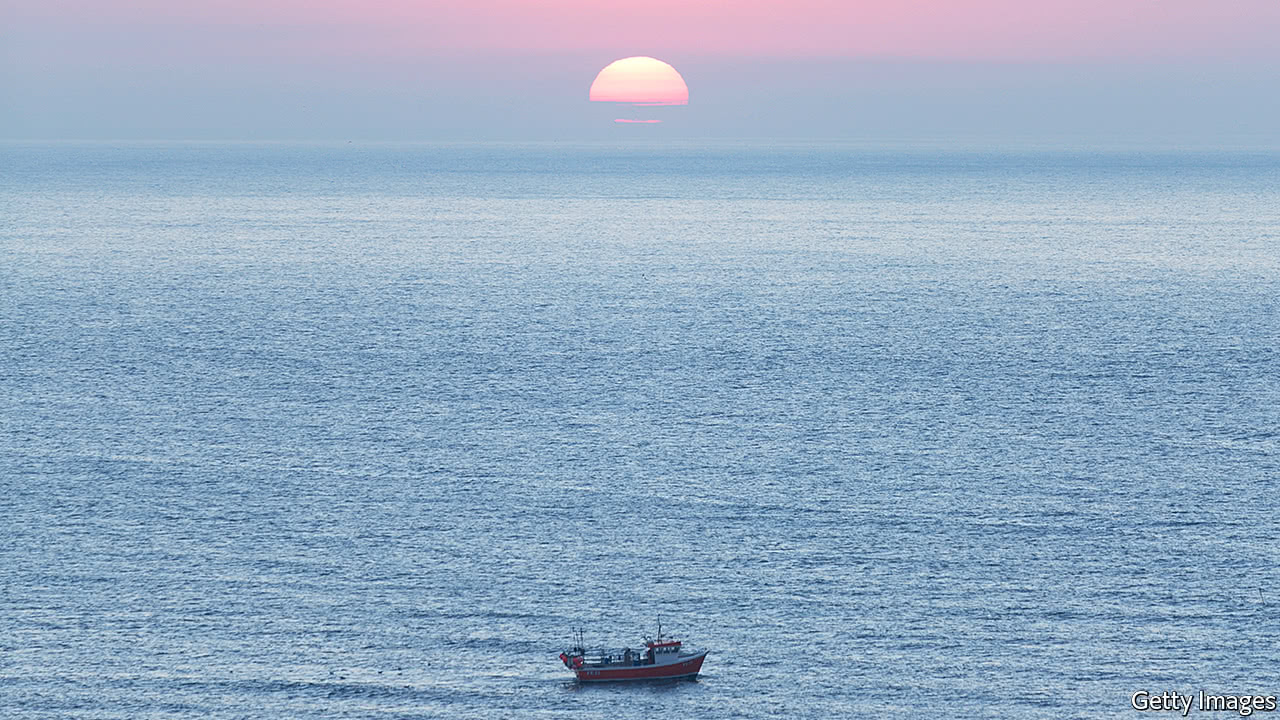Posted By Stop Illegal Fishing:27th May, 2017: Economy · Fisheries Management · Human rights · Insurance · MCS · Port State responsibilities · Sustainability · Trade
Getting serious about overfishing
EVEN the names at Sutton Harbour give it away. While the pleasure boats, including Windfall and Felicity, gleam in the sunshine, the light warms rust on the decks of craft such as Pisces. The fishing industry is struggling to stay afloat in Plymouth, a port in Devon. Locals grumble about regulation, fuel costs and the dearth of crew. Revenues are stagnant and the facilities ageing. But if times are tough for the fishers, they may be tougher for the fish.
The world currently consumes more fish per person than ever before—about 20 kilos a year. But almost all the recent gains in production have been down to farmed fish. Aquaculture has grown remarkably in the past decades, especially in China; in 2014 it accounted for half of all the fish people ate. But that does not mean that the pressure on the open seas has eased.

In 2013, the most recent year for which full data are available, 32% of the world’s fish stocks were being exploited beyond their sustainable limit, up from 10% in the 1970s, according to the UN’s Food and Agriculture Organisation. The amount of fish caught at sea has been pretty much flat for the past three decades, but the share of the world’s fish stocks that are being plundered unsustainably has continued to increase (see chart 1).
Overfishing is not the only problem. Pollution, notably fertiliser run-off, damages a lot of marine ecosystems. There are estimated to be 5trn bits of plastic in the ocean, with over 8m tonnes of the stuff added every year. By the middle of the century the sea could contain more plastic than fish by weight, according to research done for the Ellen MacArthur Foundation.
Not all the harm comes directly from the land; some comes via the sky. Carbon dioxide accumulating in the atmosphere has so far raised the world’s average sea-surface temperature by about 0.7ºC. This has effects at depth; when seas warm up they become more stratified, making it harder for nutrients in the waters below to rise to where they are most needed by fish and plankton. Given this, it might seem fortunate that the ocean absorbs a fair bit of that carbon dioxide, thus reducing the warming. But doing so changes the ocean’s chemistry, making it more acidic. This is a particular problem for creatures with calcium-carbonate shells—which includes not just crabs and oysters but quite a lot of larvae, too. Acidification makes carbonates more likely to dissolve.
It is hard to grasp the scale of such planetary changes, and impossible to say how much damage they will do. That is the way of things with the ocean; it is vast and human horizons are close. That something so immense could be put at risk just by people leading their daily lives seems inconceivable. But as with the atmosphere and the surface of the continents—where humans now move more sediments than the natural processes of erosion—the fact that something is vast does not mean humans cannot have profound impacts on it.
For the sake of the hundreds of millions of people who depend on the ocean for livelihoods or sustenance, as well as for the sake of the ocean itself, these human impacts need to be reined in. There are signs that, where fishing is concerned, this may be coming about, not least because monitoring what goes on over the horizon is becoming ever easier. But there is a great deal left to do.
Losing Nemo
Overfishing is bad for fish; it is also, in the long run, bad for those seeking to catch them. The goal of sound management is to have a stock that is harvested at the same rate that it replenishes itself—which might typically be a stock about half the size of what would be there if there were no fishing at all. If fishers take more than this “maximum sustainable yield”—as they do in many fisheries today—then in the long run they will get less out of the resource than they could, quite possibly imperilling its future. If stocks were allowed to rise back up far enough for the world’s fisheries to reach their maximum sustainable yield, the industry would increase production by 16.5m tonnes—about a fifth of the current total—and bring in an extra $32bn a year.
Good management could in principle get the stocks back up through the use of quotas, property rights and other constraints on untrammelled exploitation. Quotas and similar controls have worked well in some cases. In American waters 16% of stocks were overfished in 2015, down from 25% in 2000. But they have drawbacks. Because they want to land the largest fish they can find, fishers throw back undersized specimens, which often die as a result. And because fish mix, species caught by accident are thrown back if a fisher has no quota for them.
Quotas are also often badly set. Regulators and politicians pander too much to powerful fishing interests, according to Rainer Froese of the Helmholtz Centre for Ocean Research in Kiel, Germany. Lobbies, which often benefit from the importance of fishing to specific places, push for short-term profit over long-term sustainability. “They harvest the apples by cutting the tree branches,” says Mr Froese.
The problem is exacerbated by a lack of evidence, which makes overly permissive quota-setting easier. More investment in research and monitoring could help. But in developing countries, where the need is often dire, there are frequently no resources to meet that need, and in many rich countries fishing is not a big enough industry to make such research a national priority. “We are not good value for the taxpayer, but how can you have an island nation without a fishing fleet?” asks Pete Bromley, a former fisherman who is now master of Sutton Harbour.
Aquaculture boosters might answer that fleets are simply no longer needed. But farmed fish, particularly salmon and their ilk, are fed on smaller fish that themselves are caught at sea. Insects or algae might provide alternative fodder, but the companies involved are slow to embrace such novelties, according to Ari Jadwin of AquaSelect, which provides advice to Chinese fish farms. One issue, he says, is that Chinese consumers are not moved by sustainability arguments. But he thinks that concerns over food safety will lead to better practices in the long run.
Those struggling to make money from early mornings in stormy seas worry more about business in the next year than in the next fifty. “Climate change isn’t happening next month. At the moment we’ve got to hang on to what we’ve got,” says Mr Bromley. But worrying trends are already visible. As equatorial seas warm up, many plankton species are extending their range towards the poles by hundreds of kilometres a decade; where they lead, fish will follow.
Moving somewhere cooler might seem a simple thing; but temperature is not all that matters to fish, and so there can be trade-offs involved. The flounders off the coast of Britain like water that is both relatively shallow and fairly cool, says Martin Genner from the University of Bristol. With water temperatures around the south of the country 1.5ºC higher than they used to be, the flounders have headed north—but there the waters are deeper, which suits them less well. Fish may also need particular types of food at particular times in their life cycles, such as when their larvae hatch. If predators and prey respond to warming by heading to different places, or by speeding up or slowing down their breeding at different paces, such needs will go unmet. But how much, and where, food webs will be thus disrupted is hard to say. Few of the models seeking to predict how climate change will affect fish consider ecological interactions between species.
Fixed assets
Not everything in the sea can move to waters new with the flick of a fin. Coral reefs, for example, are rather stuck. Although they cover less than a thousandth of the world’s sea floors, they support a quarter of known marine species—and through them millions of people who rely on fishing and tourism for their livelihoods. As oceans warm, corals risk “bleaching”—losing their colourful algal symbionts—because the algae involved can only survive in a slim range of temperatures. Without their algae, which photosynthesise, the corals lose their source of energy.
There have been three global bleaching episodes since 1998, worsened by El Niño events that heat up the tropical Pacific. The one that started in 2014, and is still going on, has been the longest and most damaging; more than 70% of the world’s coral reefs have been harmed by it. Australia’s Great Barrier Reef, worth $4.6bn each year to nearby Queensland alone, has been particularly badly affected. “Five or ten years ago, most of the discussion about coral reefs was over how they would look by the end of century,” says Rusty Brainard, a coral expert at America’s National Oceanic and Atmospheric Administration. “Now the talk is of whether coral reefs will survive as we know them to 2050 or even 2030.”
Acidification makes the picture worse. Though it is hard to distinguish the effects of chemistry from the other problems that beset reefs, it seems a fair bet that an environment where calcium carbonate is more likely to dissolve will not be good for them. A study published last year by researchers at the Carnegie Institution for Science made the point clearly by running de-acidified water over a reef; the corals perked up nicely. Doing the same for all the world’s reefs, though, is hardly an option.

Faced with chronic problems and hard-to-quantify future crises, the sea’s resources need to be looked after better by all those—countries, consumers, companies and fishers—with a stake in their survival.
Much of that needs to be done in national jurisdictions. Though overfishing means that many fleets now head farther from home than before, about 90% of the catch is from the “exclusive economic zones” (EEZs) that countries are entitled to claim out to as far as 200 nautical miles (370km) from their shores. What counts as a shore, and a claim, though, can be disputed: China’s assertion of fishing rights in the South China Sea, which contains a tenth of the global fish catch, sets its neighbours on edge (though it is hardly the only thing that does). Russia, America and other Arctic states argue over new access to fish stocks in the melting north.
Though what goes on in EEZs is largely a sovereign matter, there are some levers available to outsiders. The World Trade Organisation (WTO) hopes to introduce new rules on fishing subsidies at its next ministerial jamboree in December. These come to $30bn a year, with seven in every ten dollars handed out by comfortably-off countries. The WTO first started discussions on fishing subsidies back in 2001; Pascal Lamy, formerly its director-general, says a great deal of effort has gone into working out which subsidies are contributing to harmful fishing practices. The reckoning now is about 60% of them do so.
China, which gets far more fish from its EEZ than any other country does from theirs (as well as fishing, by agreement, the EEZs of other countries), seems open to action on subsidies if some unrelated anti-dumping measures are loosened. But how to bring poor countries on board remains a thorny issue. Although coastal African states want change, many inland ones fret over the higher cost of fish. “The whole point is to make fish more expensive,” explains Mr Lamy, “so as to internalise the cost of environmental depletion.” Sensible stewardship, but not necessarily an easy sell in countries where fish from elsewhere are a cheap source of protein for the poor.
Establishing more protected areas both within EEZs and on the high seas beyond would be another way to help, particularly if they were to contain “no-take” zones where fishing is completely barred. Such zones provide breathing spaces, or breeding spaces, in which stocks can recover. Crow White from California Polytechnic State University and Christopher Costello from the University of California, Santa Barbara have calculated that if such an approach was taken to its extreme and the high seas were closed to fishing, then yields elsewhere could rise by 30%, with fisheries’ profits doubling because fish closer to shore become cheaper to catch.

The countries that dominate fishing in international waters (see chart 2) would never stomach such a ban; they prefer the often inadequate regulation offered by regional fisheries-management organisations. But even in these regimes, temporary and rolling closures have been tested. In the Antarctic permanent ones have proved successful.
Spotting boats that misbehave on the high seas (or indeed in EEZs) is getting easier. The International Maritime Organisation (IMO) requires ships over 300 tonnes to have an Automatic Identification System (AIS), a radio transmitter which tells anyone in the vicinity the boat’s position, speed and identity so as to avoid collisions. “In the vicinity”, though, now includes “up above”; various satellites can use AIS transmissions to track ships. Spire, an American startup, is building up a constellation of tiny spacecraft with which it hopes to log 10m AIS transmissions every day by the end of this year.
Global Fishing Watch, an online platform created by Google, Oceana, a marine charity, and Sky Truth, which uses satellite data to further environmental causes, is a keen user of AIS transmissions. They do not just let it locate fishing vessels; they let it take a good guess as to what they are doing (boats long-lining for tuna, for example, zigzag distinctively). The platform currently follows 60,000 vessels responsible for 50-60% of the world’s catch, according to Brian Sullivan from Google. Indonesia is planning to use the platform to make public data that it gathers through “vessel monitoring systems”—information which can reveal more about what is actually happening on-board than AIS location data do, and as a result is often jealously guarded. The more other countries follow suit, the better the picture will be.
The Port State Measures Agreement, which came into force in 2016, means that if such monitoring leads a country to suspect that a foreign vessel is doing something dodgy, it does not have to go out and inspect it in order to take action. The agreement’s clever construction means that poor countries without much by way of navy or coastguard can deny a suspicious foreign vessel entry to their ports and pass its details on to other countries that might have the wherewithal to check it out.

Companies can act, as well as countries. Food suppliers and retailers such as Costco, Sodexo and Walmart are trying to combat poor fishing practices through a body called the Seafood Task Force. The idea is to ensure that supply chains are what they purport to be and that labour conditions in the industry are up to snuff with an eye to fixing problems before they become scandals. And insurers are interested in the sort of monitoring Global Fishing Watch does: ships that turn their AIS off increase the risk of collisions; they may attract bigger premiums or have their policies revoked.
Investors currently have little information on how their choice of investment affects marine life. Fish Tracker, a not-for-profit firm, aims to put that right. It is looking at the risks posed by unsustainable fishing in the same way that climate activists have studied the risks of fossil-fuel investments in order to warn off investors. Mark Campanale, the initiative’s founder, says that at the most basic level investors need to understand that if one boat catches one fish, ten boats will not catch ten. To that end the outfit is analysing information covering 300 fishing companies with a market capitalisation of $530bn to calculate the unacknowledged downsides imposed by environmental limits.
None of this can drive change effectively, though, without the support of fishers. Including them in the design of regulatory regimes can bolster scientific analysis and reduce political tensions; by bringing them into the process it also deepens their understanding of sustainable practice. “It would be unacceptable for farmers to go through an educational system without understanding crop yields and the need to manage the land for future generations,” says Jim Masters of Fishing into the Future, a charity. “But there are no equivalent opportunities for fishermen.” For the sake of the fish, there should be.
Source: The Economist
Recent Posts
Zimbabwe has become the 13th country to sign the MCSCC Charter.
On the 21 November 2024, The Republic of Zimbabwe became the thirteenth signatory...
Ghana adopts high-standard procedures for PSMA implementation – leading the way for the FCWC region
On 06-08 November, SIF was in Tema, Ghana to continue the process of...
SADC Atlantic shows growing impact in Angola’s actions to fight IUU fishing
On 22-25 October 2024 in Luanda took place the third in-person training organised...